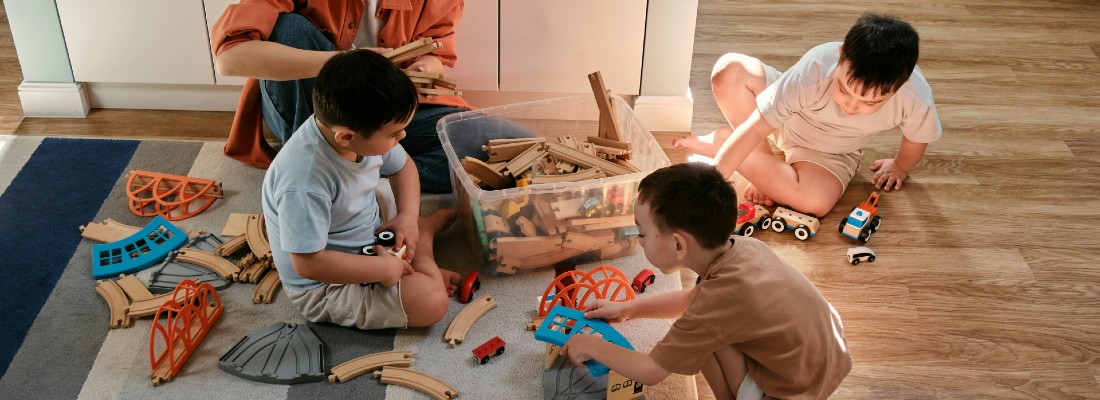Last weekend, I decided to surprise Lincoln with a DIY volcano experiment. We gathered baking soda, vinegar, and food coloring, then shaped a volcano using clay. Lincoln’s eyes widened as we mixed the ingredients, causing a colorful eruption. He laughed with delight, asking, “Can we do it again?”
We spent the afternoon exploring different “lava” colors and discussing the science behind the reaction. Later, Lincoln proudly showed his dad the volcano, explaining how it worked.
Seeing his excitement and newfound knowledge, I realized these simple at-home experiments could spark a lifelong love for learning and discovery.
What Are STEM Kits for Kids?
STEM kits for kids are educational tools designed to teach Science, Technology, Engineering, and Math concepts through hands-on activities and projects.
These kits, often referred to as activity kits, include materials and instructions for children to engage in experiments, building projects, and learning activities that make STEM subjects fun and accessible.
Introduction to STEM Kits
STEM kits are an excellent way to introduce children to the world of science, technology, engineering, and mathematics. These kits are designed to provide hands-on activities that foster creativity, curiosity, and critical thinking skills.
With a wide range of STEM kits available, parents and educators can choose the perfect kit to suit a child’s age, interests, and learning style. STEM kits offer a fun and interactive way to learn and explore, from robotics and coding to science experiments and engineering projects.
Benefits of STEM Learning
STEM kits offer numerous benefits for children’s educational development:
- Hands-on Learning: Science kits for kids provide tangible experiences that reinforce abstract concepts, making learning more engaging and memorable. Activity kits are essential tools for teaching STEM concepts through engaging, hands-on experiences for children of various ages.
- Critical Thinking: Engineering toys for kids challenge children to solve problems creatively, enhancing their analytical skills.
- Technological Literacy: Tech toys for kids introduce basic coding and robotics concepts, preparing children for an increasingly digital world.
- Mathematical Reasoning: Math toys help children develop numerical skills through practical applications, fostering a deeper understanding of mathematical concepts.
- Curiosity Cultivation: STEM kits spark children’s natural curiosity, encouraging them to ask questions and explore the world around them.
- Confidence Building: Completing STEM projects boosts children’s self-esteem and confidence in their abilities to tackle complex subjects.
- Collaboration Skills: Many STEM activities require teamwork, helping children develop important social and communication skills.
- Future Readiness: Exposure to STEM subjects at an early age prepares children for future academic and career opportunities in high-demand fields.
By incorporating STEM kits into a child’s learning routine, parents and educators can provide a strong foundation for lifelong learning and success in STEM-related areas.
Types of STEM Kits
STEM kits for kids come in various forms, each focusing on different aspects of Science, Technology, Engineering, and Mathematics. Activity kits are versatile tools that can stimulate curiosity and promote learning in subjects like physics and biology while appealing to different learning preferences.
These kits provide hands-on learning experiences tailored to specific areas of study, helping children develop a well-rounded understanding of STEM subjects.
Science Kits
Science kits for kids offer exciting experiments and activities that spark curiosity about the natural world. These activity kits are designed to provide hands-on experiences that make learning about the natural world engaging and fun. These kits cover a range of scientific disciplines:
- Chemistry: The “Colorful Chemistry” kit from KiwiCo lets kids conduct vibrant chemical reactions, teaching them about molecular interactions and color changes.
- Physics and Biology: PAAS “Eggsperiments” kit uses eggs to demonstrate scientific principles through hands-on activities.
- Earth Science: “Klever Kits Amazing Science Kits” include activities like creating erupting volcanoes and growing crystal trees, introducing kids to geological processes.
National Geographic Mega Science Lab: Explore chemistry, physics, and geology with over 15 experiments, fostering curiosity through hands-on learning and scientific discovery.
4M Volcano Making Kit: Build and erupt your own volcano while learning about chemical reactions in this fun, interactive earth science experiment.
Technology Kits
Tech toys for kids introduce young learners to coding, robotics, and electronics. These activity kits introduce young learners to coding, robotics, and electronics through engaging, hands-on projects:
- Coding Kits: These include visual programming tools and simple robots that kids can program.
- Electronics Sets: Children learn about circuits and electronic components by building their own devices.
- 3D Printing: Some kits introduce kids to 3D modeling and printing technology.
Snap Circuits Jr. Electronics Exploration Kit: Introduces kids to basic electrical engineering by allowing them to create over 100 projects with easy-to-connect snap pieces.
Sphero Mini Robot: A small programmable robot ball that helps kids learn coding through engaging activities, games, and creative problem-solving challenges.
Engineering Kits
Engineering toys for kids encourage problem-solving and creativity. These activity kits encourage problem-solving and creativity through hands-on engineering projects:
- Building Sets: LEGO and K’NEX kits allow kids to construct complex structures and machines.
- Mechanical Kits: These focus on gears, levers, and pulleys to teach mechanical engineering concepts.
- Architectural Sets: Kids can design and build miniature buildings and bridges.
- Geometry Sets: These include shape-based puzzles and construction kits.
- Counting Games: Board games and card sets that reinforce basic arithmetic skills.
- Fraction Tools: Hands-on materials that visualize fractions and ratios.
- Logic Puzzles: Brain teasers and strategy games that develop mathematical thinking.
Fun Robot Building Set: An interactive STEM kit where kids can build and code robots, boosting creativity through hands-on engineering and programming.
K’NEX Education STEM Explorations: Swing Ride Building Set: This kit introduces kids to mechanical engineering by building a swing ride and other amusement park-themed projects.
Choosing the Right STEM Kit
Selecting the appropriate STEM kit for your child is crucial to maximize their learning experience and engagement.
Activity kits are a versatile option that can cater to different interests and learning styles. Consider these factors when making your choice:
Age-Appropriate Options
When choosing science kits for kids, age-appropriateness is paramount. Activity kits are available for different age groups, making them a flexible choice for parents and educators.
For younger children (ages 4-7), opt for kits like STEM Powered Kits, which focus on basic STEM concepts through hands-on activities. These kits align with national education standards and foster creativity and cognitive development.
For elementary school students (ages 7-10), consider engineering toys for kids like those offered by KiwiCo.
These kits come with all the necessary materials and step-by-step guides, making them ideal for this age group.
STEM Kits for Kids Ages
STEM kits are suitable for children of various ages, from preschool to high school. For younger children, kits that focus on basic science concepts, such as magnets, colors, and shapes, are ideal.
As children grow older, they can progress to more complex kits that introduce programming, robotics, and engineering principles. Some popular age ranges for STEM kits include:
- Preschool (3-5 years): Simple science kits, sensory play kits, and introductory coding kits
- Elementary school (6-10 years): Science experiment kits, robotics kits, and basic programming kits
- Middle school (11-14 years): More advanced robotics kits, engineering kits, and coding kits
- High school (14+ years): Advanced engineering kits, programming kits, and specialized STEM kits
Individual vs. Classroom Kits
Individual STEM kits are designed for personal use at home, catering to a child’s specific interests and learning pace. These kits often include detailed instructions and materials for multiple projects, allowing for repeated use and exploration. Activity kits can be used both individually and in classroom settings, providing flexibility in how they are utilized.
Classroom kits, on the other hand, are created for group settings and typically contain materials for multiple students to work simultaneously.
These kits often focus on collaborative learning that you can use if you have several children or you want your little ones to learn STEM with other neighborhood children.
When choosing between individual and classroom kits, consider:
- Learning environment: Home-based or school-based learning
- Number of children: Single child or multiple students
- Budget: Individual kits may be more cost-effective for single users, while classroom kits offer better value for groups
- Complexity: Individual kits often allow for more in-depth exploration, while classroom kits may cover broader topics
To ensure an engaging and effective STEM learning experience, select the kit type that best suits your child’s learning environment and needs.
Key Features of STEM Toys
STEM toys and kits are designed to provide a fun and interactive learning experience for children. Some key features of STEM toys include:
- Hands-on activities: STEM toys encourage children to engage in hands-on activities that promote learning and exploration.
- Interdisciplinary learning: STEM toys often combine multiple subjects, such as science, technology, engineering, and mathematics, to provide a comprehensive learning experience.
- Problem-solving skills: STEM toys help children develop problem-solving skills, critical thinking, and creativity.
- Real-world applications: Many STEM toys are designed to mimic real-world applications, making learning more relevant and engaging.
- Fun and interactive: STEM toys are designed to be fun and interactive, making learning an enjoyable experience for children.
Popular STEM Kit Activities
STEM kits for kids offer a wide range of engaging activities that make learning fun and interactive. Activity kits offer a wide range of engaging activities that make learning fun and interactive.
These hands-on experiences cover various aspects of science, technology, engineering, and mathematics, providing children with valuable skills and knowledge.
Coding and Robotics
Tech toys for kids focus on coding and robotics, introducing children to the world of programming and automation. These activity kits introduce children to the world of programming and automation through hands-on projects. These activities include:
- Building and programming solar-powered robots with kits like the Sillbird STEM 12-in-1 Education Solar Robot Toys
- Learning basic coding concepts through interactive games and puzzles
- Creating simple apps and animations using kid-friendly coding platforms
- Assembling and controlling robotic arms or vehicles to understand mechanical principles
By engaging in these coding and robotics activities, children develop logical thinking, problem-solving skills, and gain valuable experience with technology that will benefit them in future academic and career pursuits.
STEM Kit Subscriptions
STEM kit subscriptions offer a convenient way to provide your children with regular doses of engaging science, technology, engineering, and math activities. Many subscription services offer activity kits that provide regular doses of engaging, hands-on STEM activities. These services deliver curated kits directly to your doorstep, ensuring a continuous stream of educational experiences for young learners.
STEM Powered Kits
Although STEM Powered Kits doesn’t offer subscription plans, their one-time purchase options provide comprehensive and affordable alternatives. These activity kits are designed for children aged 4 and up, providing comprehensive and affordable educational content.
These kits are designed for children aged 4 and up and cost 55% less than competitors. STEM Powered Kits align with national education standards, ensuring quality educational content in each package.
These kits provide regular opportunities for hands-on learning, sparking curiosity and developing critical thinking skills in science, technology, engineering, and math.
Integrating STEM Kits into Education
STEM kits offer a powerful way to enhance learning in both educational settings and home environments.
Activity kits offer engaging experiences that align with educational standards and foster critical thinking skills. These hands-on tools provide engaging experiences that align with educational standards and foster critical thinking skills.
Educational Settings
STEM kits revolutionize classroom learning by providing hands-on experiences that bring abstract concepts to life. Activity kits provide hands-on experiences that bring abstract concepts to life in the classroom.
KiwiCo’s Elementary STEM Kits, designed by experts and tested by educators, align with national education standards and include all necessary materials and step-by-step guides.
This reduces teacher preparation time and ensures a high-quality learning experience.
These kits promote free inquiry and self-directed learning, encouraging students to engage in critical thinking and problem-solving activities.
Educators create an interactive learning environment that sparks curiosity and fosters a deeper understanding of STEM concepts by integrating science kits for kids, engineering toys for kids, and math toys into the curriculum.
Home Learning
STEM kits excel in home learning environments, offering parents an effective way to supplement their child’s education.
Activity kits offer parents an effective way to supplement their child’s education with hands-on learning experiences.
Tech toys for kids, such as coding kits and robotics sets, introduce children to cutting-edge technologies in a fun, accessible manner. These hands-on activities allow kids to explore real-world problems, ask questions, and find solutions through experimentation.
Engineering toys for kids encourage creativity and problem-solving skills at home. Building sets and mechanical kits challenge children to think critically and apply scientific principles to practical situations.
By incorporating STEM kits into home learning routines, parents provide their children with valuable opportunities to develop skills that will benefit them in future academic and professional pursuits.
Conclusion
STEM kits offer an exciting gateway to the world of science technology engineering and math for children. By integrating these educational tools into your child’s learning routine you’re fostering curiosity critical thinking and problem-solving skills.
Whether used in classrooms or at home STEM kits provide hands-on experiences that make complex concepts accessible and enjoyable. With a wide variety of options available you can choose kits that match your child’s interests and developmental stage.
Investing in STEM kits today can spark a lifelong passion for learning and set your child up for success in our increasingly tech-driven world.













0 Comments